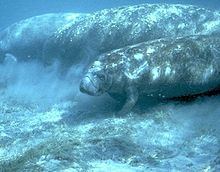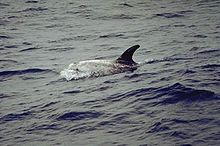- List of mammals of Anguilla
-
This is a list of the mammal species recorded in Anguilla. There are 4 mammal species in Anguilla, of which 0 are critically endangered, 0 are endangered, 1 is vulnerable, and 0 are near-threatened.[1]
The following tags are used to highlight each species' conservation status as assessed by the IUCN:
EX Extinct No reasonable doubt that the last individual has died. EW Extinct in the wild Known only to survive in captivity or as a naturalized populations well outside its previous range. CR Critically Endangered The species is in imminent risk of extinction in the wild. EN Endangered The species is facing an extremely high risk of extinction in the wild. VU Vulnerable The species is facing a high risk of extinction in the wild. NT Near Threatened The species does not meet any of the criteria that would categorise it as risking extinction but it is likely to do so in the future. LC Least Concern There are no current identifiable risks to the species. DD Data Deficient There is inadequate information to make an assessment of the risks to this species. Some species were assessed using an earlier set of criteria. Species assessed using this system have the following instead of Near Threatened and Least Concern categories:
LR/cd Lower Risk/conservation dependent Species which were the focus of conservation programmes and may have moved into a higher risk category if that programme was discontinued. LR/nt Lower Risk/near threatened Species which are close to being classified as Vulnerable but are not the subject of conservation programmes. LR/lc Lower Risk/least concern Species for which there are no identifiable risks. Contents
Subclass: Theria
Infraclass: Eutheria
Order: Sirenia (manatees and dugongs)
Sirenia is an order of fully aquatic, herbivorous mammals that inhabit rivers, estuaries, coastal marine waters, swamps, and marine wetlands. All four species are endangered.
- Family: Trichechidae
-
- Genus: Trichechus
- West Indian Manatee Trichechus manatus VU
- Genus: Trichechus
-
Order: Chiroptera (bats)
The bats' most distinguishing feature is that their forelimbs are developed as wings, making them the only mammals in the world naturally capable of flight. Bat species account for about 20% of all mammals.
- Family: Phyllostomidae
- Subfamily: Glossophaginae
- Genus: Monophyllus
- Insular Single Leaf Bat Monophyllus plethodon LR/nt
- Genus: Monophyllus
- Subfamily: Glossophaginae
Order: Cetacea (whales)
The order Cetacea includes whales, dolphins and porpoises. They are the mammals most fully adapted to aquatic life with a spindle-shaped nearly hairless body, protected by a thick layer of blubber, and forelimbs and tail modified to provide propulsion underwater.
- Suborder: Odontoceti
- Superfamily: Platanistoidea
- Family: Delphinidae (marine dolphins)
- Genus: Lagenodelphis
- Fraser's Dolphin Lagenodelphis hosei DD
- Genus: Grampus
- Risso's Dolphin Grampus griseus DD
- Genus: Lagenodelphis
- Family: Delphinidae (marine dolphins)
- Superfamily: Platanistoidea
Notes
- ^ This list is derived from the IUCN Red List which lists species of mammals and includes those mammals that have recently been classified as extinct (since 1500 AD). The taxonomy and naming of the individual species is based on those used in existing Wikipedia articles as of 21 May 2007 and supplemented by the common names and taxonomy from the IUCN, Smithsonian Institute, or University of Michigan where no Wikipedia article was available.
References
- "The IUCN Red List of Threatened Species: Mammals of Anguilla". IUCN. 2001. http://www.iucnredlist.org/search/search.php?kingname=ANIMALIA&phyname=CHORDATA&claname=MAMMALIA&freetext=&modifier=phrase&criteria=wholedb&taxa_species=1&redlistCategory%5B0%5D=all&redlistAssessyear%5B0%5D=all&country%5B0%5D=AI&aquatic%5B0%5D=all®ions%5B0%5D=all&habitats%5B0%5D=all&threats%5B0%5D=all&Submit_x=34&Submit_y=9&extendedResults=0&terrestrial=0&marine=0&freshwater=0&offset=0&sortorder%5B0%5D=spcscientificname&sortorder%5B1%5D=genname&sortorder%5B2%5D=spcname&sortorder%5B3%5D=spcauthor&sortorder%5B4%5D=spcinfrarank&sortorder%5B5%5D=spcinfraepithet&sortorder%5B6%5D=spcinfrarankauthor&sortorder%5B7%5D=spcstockname&sortorder%5B8%5D=comname_comp&sortorder%5B9%5D=rlcabb&sortorder%5B10%5D=rlscriteria&sortorder%5B11%5D=poptrend_code&sortorder%5B12%5D=rlcatcrit2001&sortorder%5B13%5D=spcrecid&sortorder%5B14%5D=kingname&debug=0&taxa_subspc=0&taxa_stock=0&newsort=Genus. Retrieved 22 May 2007.[dead link]
- "Mammal Species of the World". Smithsonian National Museum of Natural History. 2005. Archived from the original on 27 April 2007. http://web.archive.org/web/20070427043030/http://nmnhgoph.si.edu/msw/. Retrieved 22 May 2007.
- "Animal Diversity Web". University of Michigan Museum of Zoology. 1995-2006. http://animaldiversity.ummz.umich.edu/site/index.html. Retrieved 22 May 2007.
See also
- List of chordate orders
- List of regional mammals lists
- List of prehistoric mammals
- Mammal classification
- New mammal species
List of mammals of North America Sovereign states Dependencies and
other territories- Anguilla
- Aruba
- Bermuda
- Bonaire
- British Virgin Islands
- Cayman Islands
- Curaçao
- Greenland
- Guadeloupe
- Martinique
- Montserrat
- Puerto Rico
- Saint Barthélemy
- Saint Martin
- Saint Pierre and Miquelon
- Saba
- Sint Eustatius
- Sint Maarten
- Turks and Caicos Islands
- United States Virgin Islands
Categories:- Lists of mammals by location
- Mammals of Anguilla
- Anguilla-related lists
- Family: Trichechidae
Wikimedia Foundation. 2010.


